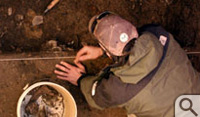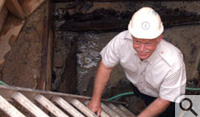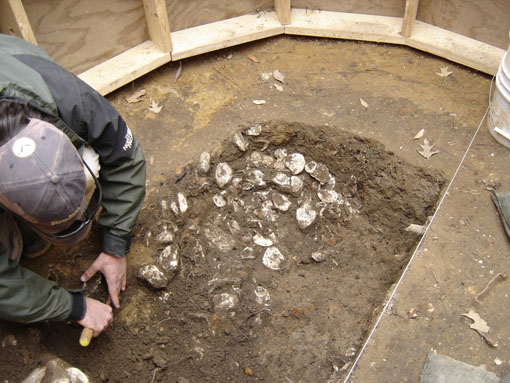The Starving Time
VIMS oyster study confirms early Jamestown drought
A study of 400-year-old oyster shells from North America's first permanent English colony confirms that a harsh drought plagued the early years of the Jamestown settlement.
The investigation, led by researcher Juliana Harding of the Virginia Institute of Marine Science, used chemical signatures within oyster shells from an abandoned Jamestown well to reveal that the James River was much saltier between 1609 and 1612 than today, likely due to a drought-induced decrease in runoff from nearby freshwater rivers.
 The study, published in the May 31 online edition of the Proceedings of the National Academy of Sciences, confirms results from an earlier tree-ring analysis, which showed that the colonists arrived in Virginia in the middle of a severe regional drought that persisted from 1606 to 1612-the driest seven years in nearly eight centuries. The drought caused crop failures for the native Algonquin people, reducing the likelihood that the colonists could successfully barter for large quantities of food.
The study, published in the May 31 online edition of the Proceedings of the National Academy of Sciences, confirms results from an earlier tree-ring analysis, which showed that the colonists arrived in Virginia in the middle of a severe regional drought that persisted from 1606 to 1612-the driest seven years in nearly eight centuries. The drought caused crop failures for the native Algonquin people, reducing the likelihood that the colonists could successfully barter for large quantities of food.
Dr. Harding and Professor Roger Mann of VIMS teamed with colleagues Howard Spero from the University of California Davis and Gregory Herbert and Jennifer Sliko of the University of South Florida to examine oxygen isotopes in discarded oyster shells from a recently discovered freshwater well within the footprint of James Fort. The ratio between "oxygen 18"-an isotope of oxygen with two extra neutrons in its nucleus-and the more common oxygen-16 isotope can reveal the salinity of the water in which an oyster lays down its calcium carbonate shell.
 Their isotopic analysis showed that in 1611, the James River near Jamestown averaged 16 salinity units during winter, compared to 3 to 10 salinity units during wintertime today. This difference corresponds to a 40-50 per cent reduction in freshwater runoff from local rivers compared to today. Full seawater averages 35 salinity units.
Their isotopic analysis showed that in 1611, the James River near Jamestown averaged 16 salinity units during winter, compared to 3 to 10 salinity units during wintertime today. This difference corresponds to a 40-50 per cent reduction in freshwater runoff from local rivers compared to today. Full seawater averages 35 salinity units.
Harding notes that these conditions "promoted oyster growth and extension of oyster reefs more than 12 miles upriver towards Jamestown, giving the colonists the small advantage of an increased oyster supply during the drought." During and immediately after the winter of 1609-1610 ("The Starving Time") the settlers relied on oysters for food as they recovered from a winter in which nearly half of the colony died from causes including shortages of food and fresh water.
The isotopic data also allowed Harding and colleagues to determine the season of harvest for the oysters in the well-whether during the cooler conditions of early winter or the warmer conditions of late spring and summer. Paired with archeological evidence, this knowledge describes either a 1611 well with a very short period of active use, or an undocumented older well abandoned in late 1611.
The research team says that their shell-examination technique can also be extended to other archeological sites. 
















